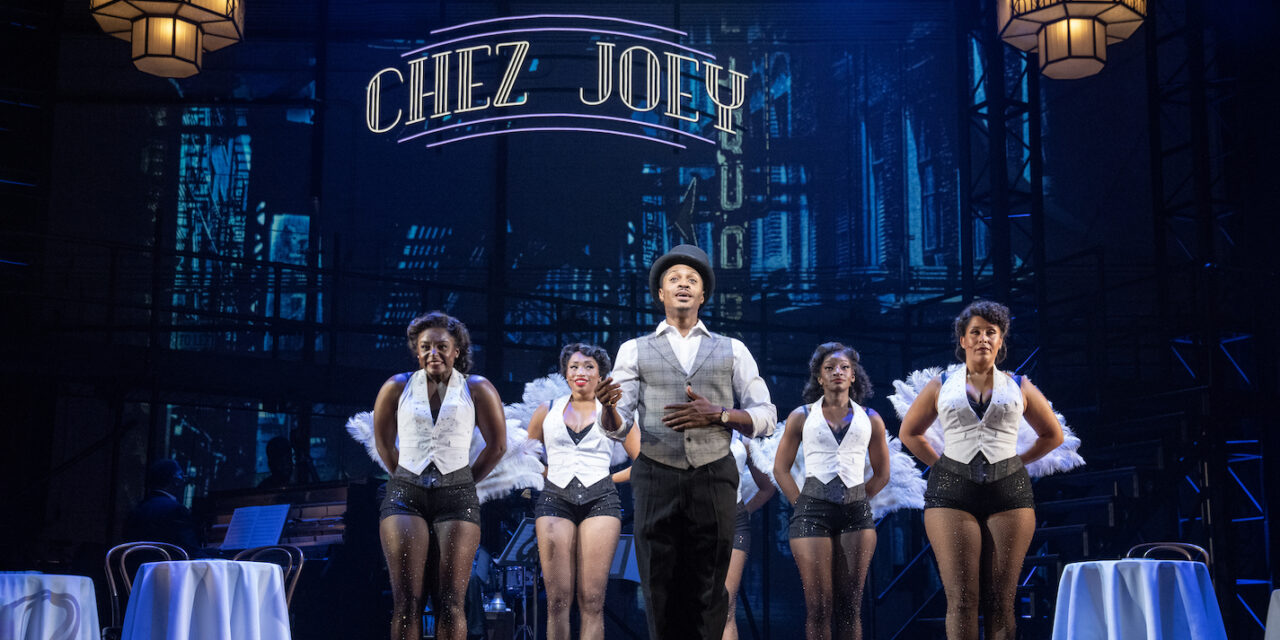By Brian Scott Lipton . . .
There are two questions on the lips of almost every patron entering New York City Center this week for its “revisal” of the 1940 Rodgers and Hart musical Pal Joey.
If you are a theater aficionado, you’re dying to know how different the show is from its original production—or even the many other “revisals” that have graced Broadway in the past 80-something years.
And even if you don’t know the show—loosely based on the short stories of the late John O’Hara—you’ll simply want to know if this new version (co-directed by the actor Tony Goldwyn and the dancer Savion Glover) “works” enough in its current form.

Second thing’s first—although the questions are clearly interconnected – this Pal Joey is ambitious, socially conscious and, alas, only modestly entertaining. It’s entirely overstuffed with way too many songs (only six or so remain from the original score, with another 15 or so Rodgers and Hart classics wedged in, some really uncomfortably) and a lot of brilliant-to-watch, but frankly unnecessary, choreography from Glover (who does some superb hoofing) that stretches the show past two and a half hours and most viewers’ patience. (Goldwyn’s often snail-like pacing of the book scenes doesn’t help matters!)
There are also a handful of new or re-thought characters, only one of whom we really need: the sassy yet worldly-wise club manager Lucille, brought to blazing life by the aptly named Loretta Devine. True, kudos also belong to the irrepressible Brooks Ashmanskas as society reporter Melvin (formerly Melba), who steals the show briefly with the ultra-witty “Zip.” (Then again, so did Elaine Stritch and Helen Gallagher in previous productions.)
Still, I haven’t gotten to the biggest change. In Richard LaGravenese and Daniel “Koa” Beatty’s brand-new book, Joey (the charismatic Ephraim Sykes, who’s also a terrific dancer) is now a black man facing a world that seems “unready” for the jazzy new sound he wants to bring to the masses. (Daryl Waters has rearranged almost every song to give them a jazz sound, a change that not all of this beloved catalog can withstand.) He also wants to be a world-famous, household name. Can he accomplish either goal?


Because at least part of his mission is noble, the writers expect us to forgive Joey his many transgressions, most notably throwing over his instant-true-love, singer Linda English (a strong-voiced but slightly bland Aisha Jackson) to shack up with wealthy socialite Vera Simpson (a haughty Elizabeth Stanley) who owns the club Joey works in. Moreover, we’re expected to believe that Vera is so bewitched and bothered by the handsome, talented Joey that she throws all common sense (and the rest of the money left to her by her late gangster husband) out the window after one night in bed together.
Did I mention that Vera is white—which means the couple could go to jail if their relationship is made public? (The same goes for Lucille and her beau, Tony—played by a game Jeb Brown—but they don’t seem to know or care about this obvious complication!) This issue should feel far weightier than it does, rather than the ridiculous plot device that it eventually becomes. Further, an even bigger issue is that Joey isn’t remotely in love with Vera—his heart (big or small) still belongs to Linda, but we really don’t care if they eventually reunite with each other.
The show’s production, unlike those for City Center’s Encores! series, keeps the orchestra off the stage of Derek McLane’s vast nightclub set (which sadly could use a turntable or something for the script’s many scene changes), while Emilio Sosa’s period costumes are clearly the show’s visual strength.
But what this show needs more than any strong visual is a strong vision, and one can’t help but feel that this “revisal” is what happens when you have two writers and two directors on one project. In every way, this Pal Joey proves that “more” is sometimes a bad four-letter word.
Pal Joey. Through November 5 at New York City Center (131 West 55th Street, between Sixth and Seventh Avenues). www.nycitycenter.org
Photos: Joan Marcus


















